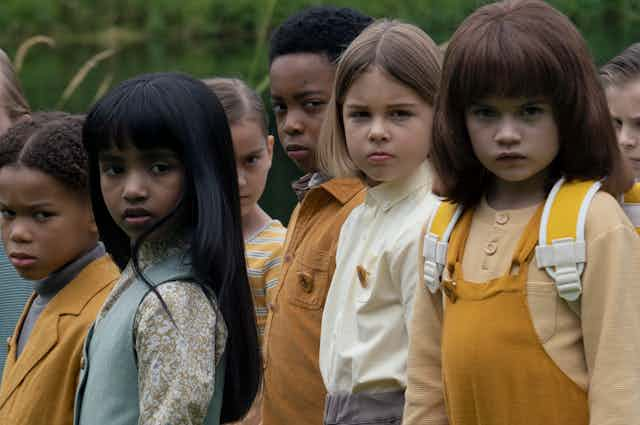The sleepy English village of Midwich is mysteriously cut off from the outside world by an invisible barrier. After the spell is lifted, the villagers discover that every woman of childbearing age has fallen pregnant. When the women simultaneously give birth, it soon becomes clear that their children are not normal. They grow too quickly, understand too much, and can communicate with each other telepathically. Worst of all, they kill anybody who threatens their collective interests.
Evil children have been a horror and science fiction staple since The Bad Seed (1956). But there’s something about British science fiction writer John Wyndham’s 1957 novel The Midwich Cuckoos that writers and directors keep coming back to.
The book was first adapted for film as Village of the Damned in 1960, then as Children of the Damned in 1964, and again as Village of the Damned in 1995, with the setting transposed to California. Now, back on its English turf and under its original title, it becomes a Sky mini-series.
Why does this story return to our screens every 30 years or so? Our continued fascination with the glowing-eyed “Midwich Cuckoos” reflects uncertainties about the rising generation. Their reappearance heralds concerns about whether parents can cope with their offspring and prepare them for their adult futures.
Extraordinary children in the cold war
This kind of unnatural child first appears in British films in the early 1960s. Other examples include The Innocents (1961), The Damned (1963), Lord of the Flies (1963) and A High Wind in Jamaica (1965). Unlike the Cuckoos, children in these films are not always evil. However, they are all “extraordinary” – they don’t behave or think in the way “normal” children should.
Postwar Britain saw a significant shift in ideas about “normal” childhood – a shift that still affects the way we think about children today. Childhood, rather than being seen as a gradual progression towards adulthood, became popularly conceptualised as a series of developmental psychological stages from the 1950s onwards. Children moved through this sequence of stages not by working harder or gaining more experience, but simply by getting older.
In this new understanding of childhood, the healthy, well-adjusted child acquired specific capacities at set ages, and both precocity and “backwardness” were undesirable. Social and emotional milestones became as significant as physical and intellectual ones. For example, schools started to use record cards to assess children’s sociability and emotional stability, with “self-centred and solitary” children scoring badly.
Given these stringent expectations, more pressure was placed upon parents and caregivers to shape their children into citizens of the future, preserving the societal gains that Britain had won in the second world war. The expanded welfare state, for example, with its National Health Service, social security and housing provision, required more active participation from its beneficiaries. At the same time, the early cold war and the risk of nuclear annihilation, epitomised by the Cuban Missile Crisis of 1962, threatened the future adults could provide.
The original Midwich Cuckoos reflected these contradictory anxieties. Their intellectual genius, blank faces and unnatural emotional control indicate that they are “not kids”, because they do not perform childhood as children should. Their future depends on unquestioning domination, and they are only thwarted by being murdered by a bomb.
Uncanny children at the turn of the millennium
The 1995 American remake prefigured a new international wave of millennial “uncanny children” films. Film scholar Jessica Balanzategui considers examples from Japan (Ringu, 1998), America (The Sixth Sense, 1999), Spain (The Devil’s Backbone, 2001) and Britain (The Others, 2001).
These films, Balanzategui argues, emerged alongside new worries about children’s precocious development and the unravelling of national economic progress and political consensus in the Global North, as Japan’s economy collapsed in the “Lost Decade” of the 1990s. It was also a time when there was greater media interest in juvenile killers – such as the English ten-year-olds Robert Thompson and Jon Venables, who abducted and murdered toddler James Bulger in 1993.
Similar concerns had been expressed by cultural critics, including Neil Postman – whose original 1982 book The Disappearance of Childhood was revised and republished in 1994. Postman argued that television allowed children access to previously hidden adult knowledge, and that this was dangerous because children lacked self-restraint.
This mirrors the threat posed by the Cuckoos, who combine the “amorality” of childhood with fearsome power over adults. It also harks back to postwar psychological ideas about “egotistic” children who were cognitively unable to be empathetic or caring, and needed to be protected for their own good.
The Cuckoos in the 21st century
The latest resurrection of the Midwich Cuckoos should make us reflect on our own attitudes towards children. Sky’s mini-series, unlike its predecessors, puts the spotlight on the relationships between the mothers and their offspring. This new set of Cuckoos are less intellectually precocious than emotionally unnerving – they are unable to love their parents in the way children ought.
This is juxtaposed with the voluntary and involuntary sacrifices that the parents make for their hostile children, highlighting the heavy load they carry. Underlining this theme, Professor Zellaby – the psychologist hero of the story, who is female in this remake – is racked with anxiety about her adult daughter Cassie. Cassie’s mental health issues make her dependent on her mother even before she becomes pregnant with one of the Cuckoos.
The new model of childhood developed in postwar Britain put greater demands on adults because it insisted children were much less capable than they might appear. It continues to oppress both contemporary children and their parents. As children have lost their independence, they have become more reliant on adults, which means that caregivers shoulder more responsibility for a longer period of time. Nevertheless, while we still find competent children unnerving, we cannot escape the trap we have set for ourselves. In the fantasies of destruction and salvation played out by the Midwich Cuckoos, we see the continuing burden of our own concepts of childhood.

